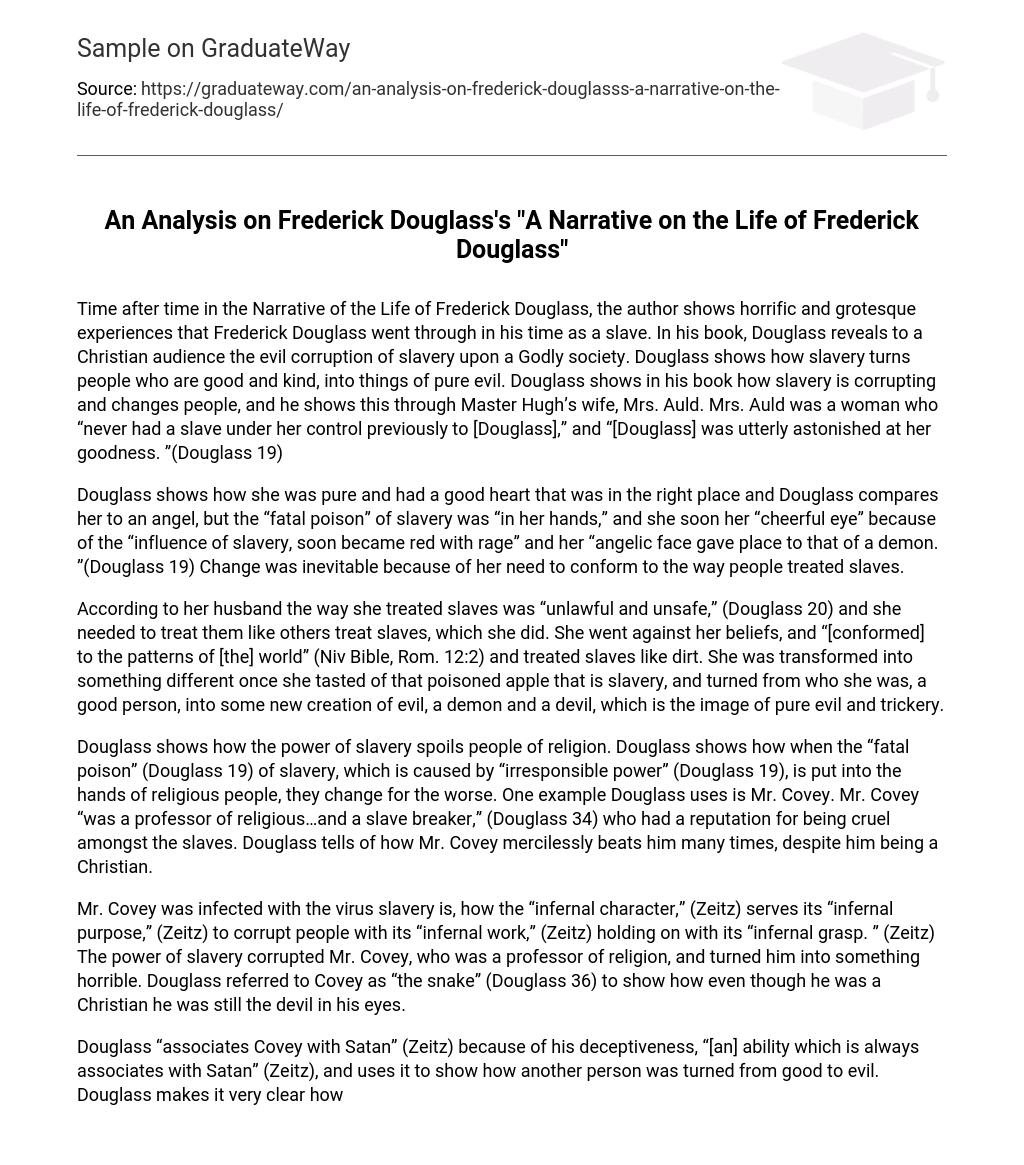Throughout the Narrative of the Life of Frederick Douglass, the author consistently portrays the disturbing and revolting experiences endured by Frederick Douglass while he was enslaved. In this work, Douglass exposes how slavery corrupts and changes individuals, demonstrating its insidious impact on a society that claims to follow Christian principles. One example of this corruption is evident in his interactions with Mrs. Auld, the wife of his owner, Master Hugh. Initially, Mrs. Auld impresses Douglass with her inherent goodness and kindness since she had never before exerted control over a slave. However, as the narrative progresses, Douglass reveals how slavery ultimately taints her character.
Douglass depicts a woman who was originally virtuous and compassionate, akin to an angel. However, due to the presence of slavery in her life, she transformed from a kind-hearted individual to one filled with anger and malice. This shift was unavoidable as she succumbed to societal norms regarding the treatment of enslaved individuals.
According to her husband, she treated slaves in a way that was considered illegal and dangerous (Douglass 20). He believed that she should treat them the same way others treat slaves. Despite her own beliefs, she decided to conform to societal norms and treated slaves poorly. This change in behavior can be attributed to her exposure to the harmful effects of slavery, which transformed her into someone completely different. She went from being a good person to embodying pure evil and deceit, resembling a demon or devil (Niv Bible, Rom. 12:2).
Douglass illustrates the detrimental impact of slavery on people’s religious beliefs. He demonstrates that when individuals who adhere to religion possess the “fatal poison” of slavery, which stems from “irresponsible power,” they undergo a negative transformation. An instance of this is exemplified through Mr. Covey, a slave breaker who also claimed to be a religious professor. Mr. Covey was notorious for his cruelty towards slaves. Despite his Christian affiliation, he repeatedly subjects Douglass to merciless beatings.
Mr. Covey, a professor of religion, was deeply affected by the slavery virus, which is described as having an “infernal character” and serves its purpose by corrupting people with its “infernal work” and gripping them with an “infernal grasp.” This corrupting power of slavery transformed Mr. Covey into something terrible. Douglass referred to him as “the snake” to highlight the contradiction of being a Christian yet embodying evil.
Douglass refers to Covey as Satan because of his deceptive nature, which is commonly associated with Satan, and uses this example to illustrate how someone can go from being good to evil. Douglass strongly portrays how slavery corrupts the very essence of Christianity. During the time of slavery, there were numerous religious debates regarding the morality of slavery. One prevalent argument was that “God cursed Ham” and his descendants, thus justifying American slavery. However, Douglass challenges this argument by highlighting that many slaves have white fathers, rendering this justification invalid. Nevertheless, people continued to argue and justify their actions using religion as a crutch. Douglass recounts the story of Thomas Auld, who became an even harsher slaveholder after “experiencing religion.” Auld found solace in his brutal treatment of slaves by interpreting scriptures in a way that supported his actions.
Auld, like other slaveholders, would misinterpret the Bible and use it as justification for his actions. According to Zeitz, many slaveholders base their justification on a misreading of the Gospel. Douglass refers to this distorted version of Christianity practiced by slaveholders as “Christianity of the land.” He describes it as a corrupt, slaveholding, and hypocritical religion. Both Thomas Auld and Covey are examples of slaveholders who practice this type of religion.
Douglass highlights the twisted ideology that justified the brutal treatment of slaves by slaveholders in the context of the prevailing “Christianity of the land”. He argues that slavery perverted Christianity, transforming it from a religion centered on love and the well-being of all individuals into a belief system driven by selfishness and animosity. Douglass vehemently condemns the corrupting influence of slavery and seeks to expose the reasons behind the atrocious behavior of slaveholders. Through various examples, he demonstrates how these individuals willingly embraced and rationalized the toxic institution of slavery, ultimately leading to the decay and demise of virtuous societies founded on Christian principles.
Works Cited
The text mentions two sources. The first source is the book “Narrative of the Life of Frederick Douglass” written by Frederick Douglass and published by Dover Publications, Inc. in New York in 1995. The second source is an article called “Biblical Allusion and Imagery in Frederick Douglass’ Narrative” written by Lisa Margaret Zeitz, published in the CLA Journal, Volume XXV, Number 1, September 1981, pages 56-64. The third source is the Holy Bible, specifically the New International Version published by Biblica in Colorado Springs in 2011.





